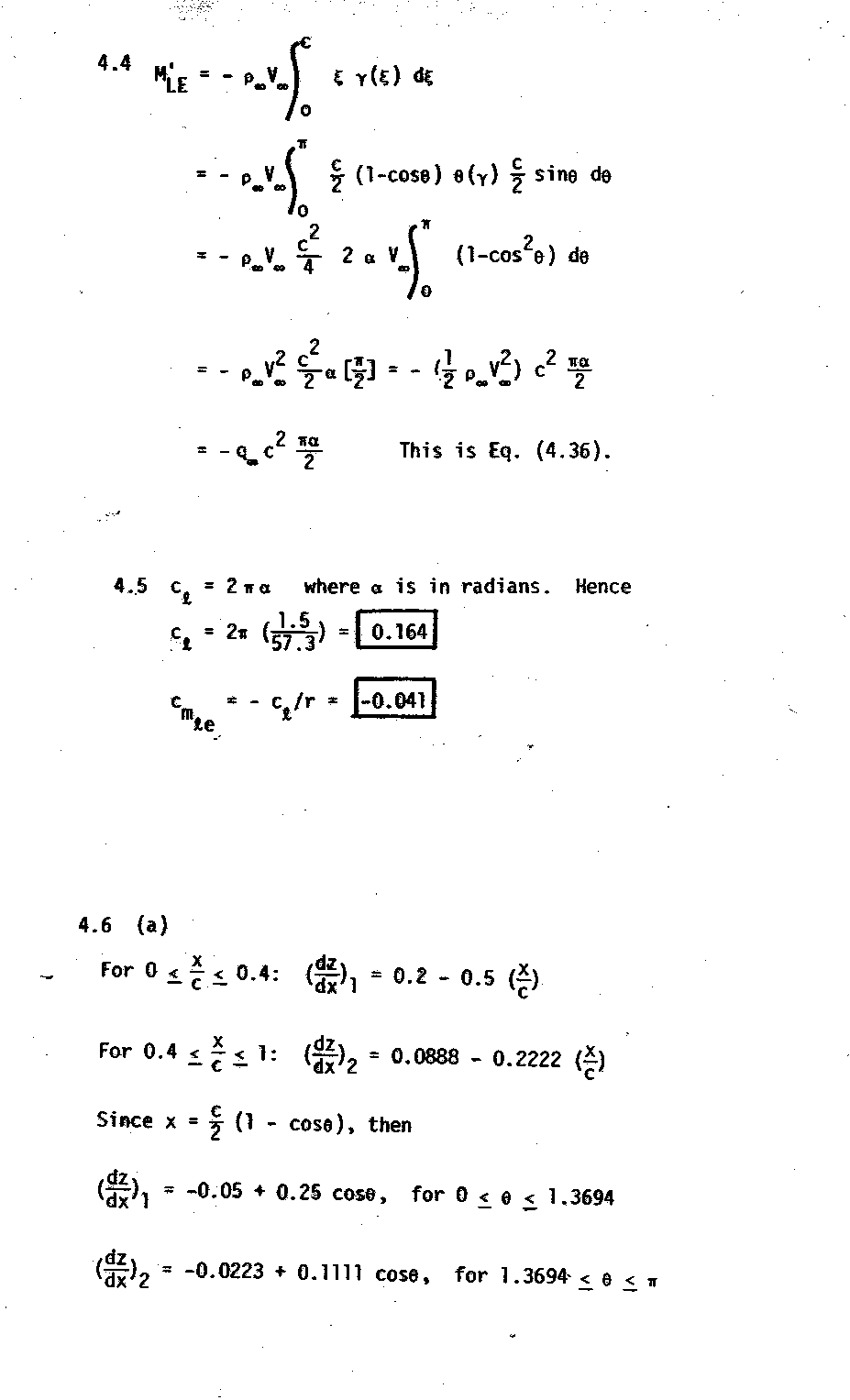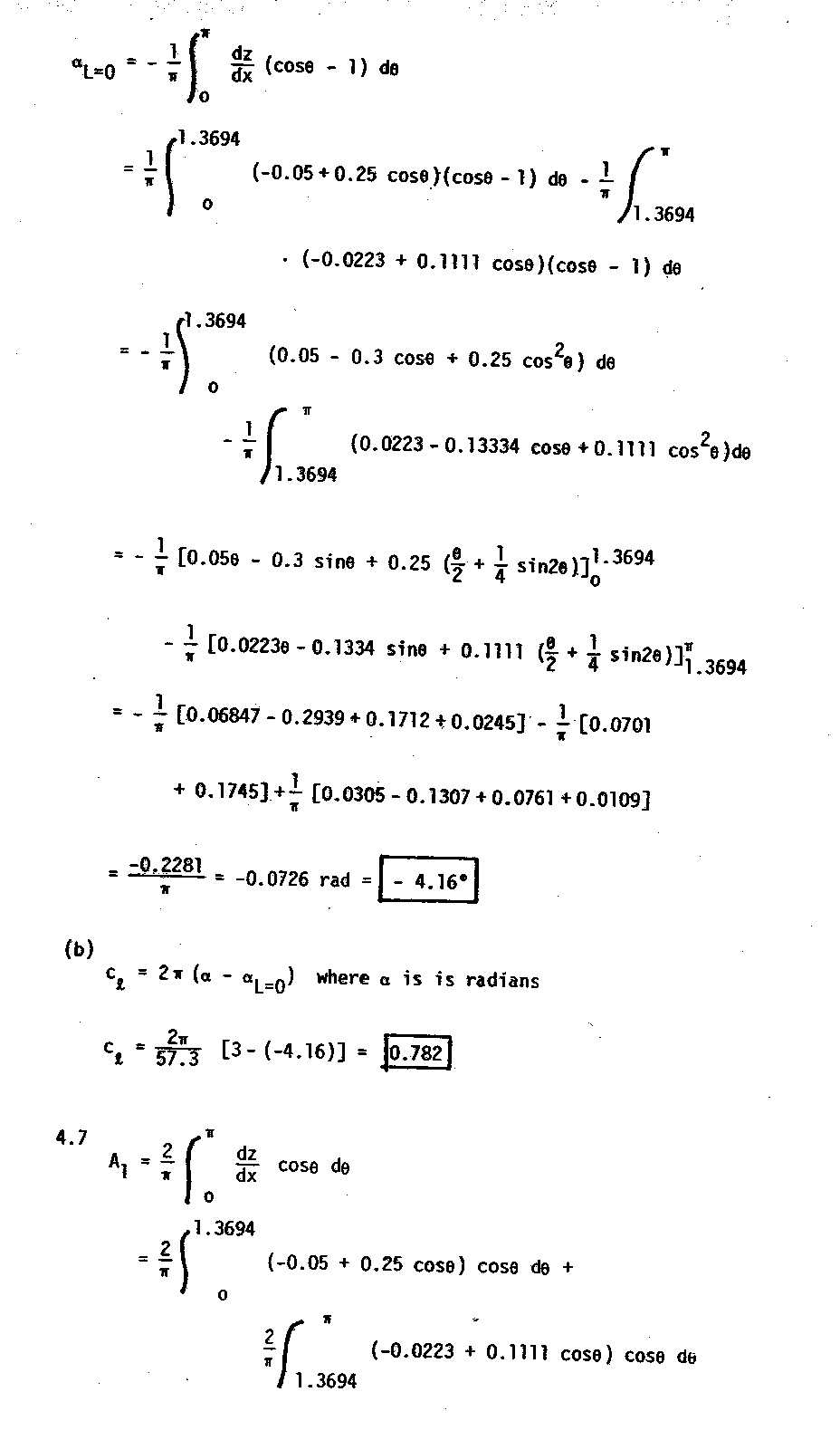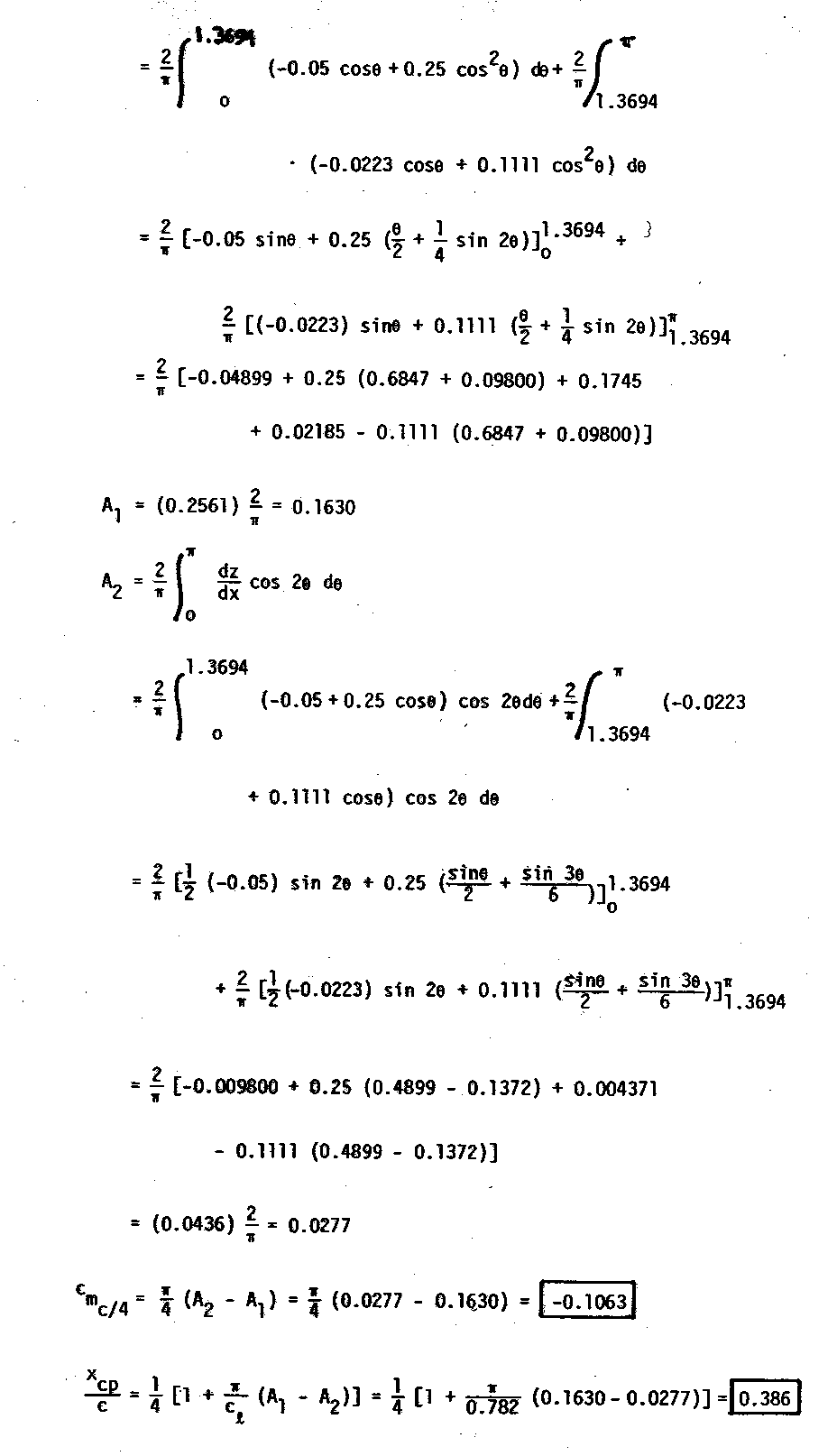MAE 3302 Aerodynamics of Incompressible Flow
Homework 9 Solution
Answers to Study Questions
- What is the Kutta condition? How does it fix the circulation around the airfoil?
ans: It is the requirement that the flow leave the airfoil smoothly at the
trailing edge. It requires the local circulation density to vanish at
the trailing edge (i.e. g(T.E.) = 0).
- What non-physical situation would exist if the Kutta condition were not met?
ans: Infinite velocity at the trailing edge.
- What condition must exist at the trailing edge if the airfoil has a finite angle there?
ans: The trailing edge must be a stagnation point.
- What condition must exist at the trailing edge of an cusped airfoil?
ans: The velocity must be equal on the upper and lower surfaces as the
trailing edge is reached.
- What is the Kutta condition in terms of the local circulation? Does this rule
hold for both finite-angle and cusped trailing edges?
ans: g(T.E.) = 0. This law holds for any sharp trailing edge.
- State Kelvin's theorem as an equation and describe what it means
in words.
ans: DG/Dt = 0. This means that the circulation around a fluid
element is unchanged as it moves with the flow (recall that this is valid
only for an incompressible, inviscid fluid).
- What is a starting vortex?
ans: It is a vortex with circulation opposite that on the wing that is created
when the aircraft accelerates from rest.
- How is the circulation about the starting vortex related to
the circulation about the airfoil? How do you know this?
ans: The circulation in the starting vortex must be equal and opposite
to the circulation on the wing. Kelvin's theorem dictates that this must
be the case in order to keep the net circulation zero.
- A general method of solution for an airfoil is to determine the strength
distribution of a vortex sheet placed on its surface. How is the placement
of the vortex sheet simplified in thin airfoil theory? Why is this
approximation allowable?
ans: The vortex sheet is placed on the mean chord line. This approximation
is permissible since the only necessary requirement is to generate a non-zero
circulation around the airfoil. This can be accomplished in a number of ways
and placing the vortex sheet on the chord line is particularly simple.
- The boundary condition used in the general method of airfoil solution
is to ensure that the airfoil surface is a streamline. How is this boundary
condition simplified in thin airfoil theory? Why is this approximation
allowable?
ans: The mean camber line is forced to be a streamline. This is permissible
if the airfoil is sufficiently thin that the streamlines that make up the real
airfoil surface are not displaced too far from the camber line.
- Is the Kutta condition applied exactly in thin airfoil theory?
Explain your answer.
ans: Yes, the circulation distribution constrained to obey the condition
g(T.E.) = 0.
- How is the expression for the velocity induced by the vortex
sheet in thin airfoil theory (Eq. 4.17) analogous to the influence
coefficient (Eq. 3.162) in the source panel method. What important
differences are there between the two?
ans: They are similar in that they both represent the component of
velocity normal to a surface that is to be a streamline that is induced
by singularity distributions used to solve the problem. They are different
in that the velocities are induced by discrete source sheets, each with
constant strength in the panel method, whereas a continuous vortex sheet
is used in thin airfoil theory.
- What does the fundamental equation of thin airfoil theory (Eq. 4.18)
represent physically?
ans: It ensures that the mean camber line is a streamline.
- What type of equation is the fundamental equation of thin airfoil
theory? How is it solved?
ans: An integral equation. It is solved via the Fourier transform method.
- The coordinate transformation x = (c/2)(1-cosq) is used
to simplify the solution to the thin airfoil problem. What values of
x correspond to q = 0, q = p/2, q = p?
ans: x = 0, c/2, c, respectively.
- What result does thin airfoil theory predict for the lift curve
slope of a symmetric airfoil?
ans: Slope is 2p, independent of a.
- According to thin airfoil theory for a symmetric airfoil, how
is the coefficient for the moment about the leading edge related to
the lift coefficient?
ans: Cmle = -Cl/4
- According to thin airfoil theory, where is the center of pressure
located for a symmetric airfoil? Does this position depend on the
angle of attack?
ans: At the quarter chord point, for all angles of attack.
- What is the definition of the aerodynamic center?
ans: The point on the chord line where the moment is indepenent of
the angle of attack.
- In what way is the solution for a thin cambered airfoil more complex
than for a symmetric airfoil?
ans: It contains an infinite collection of terms (with coefficients An)
that account for curvature of the camber line. Only A0, A1, and
A2 appear in the expressions for forces and moments, however.
- What is the significance of the coefficients An in thin airfoil
theory for a cambered airfoil?
ans: They specify the circulation distribution, and the first three of them
(A0, A1, and A2) specify the lift and moment coefficients.
- According to thin airfoil theory, does the presence of camber alter
the lift curve slope determined for a symmetric airfoil? If so how?
ans: No, the lift curve slope is still 2p even for a cambered airfoil.
- What is meant by aL = 0? How does it enter the expression
for the lift coefficient for a cambered airfoil?
ans: It is the angle of attack for zero lift. Cl = 2p( a- aL = 0 ).
- The moment coefficient for a cambered airfoil depends on which
of the An's? How is the coefficient for the moment about the quarter
chord different from that of a symmetric airfoil?
ans: Only on A0, A1, and A2. The moment about the quarter
chord is not zero for a cambered airfoil.
- What is the location of the aerodynamic center for a cambered airfoil?
ans: At the quarter chord point.



File translated from TEX by TTH, version 2.00.
On 3 Dec 1999, 12:21.





